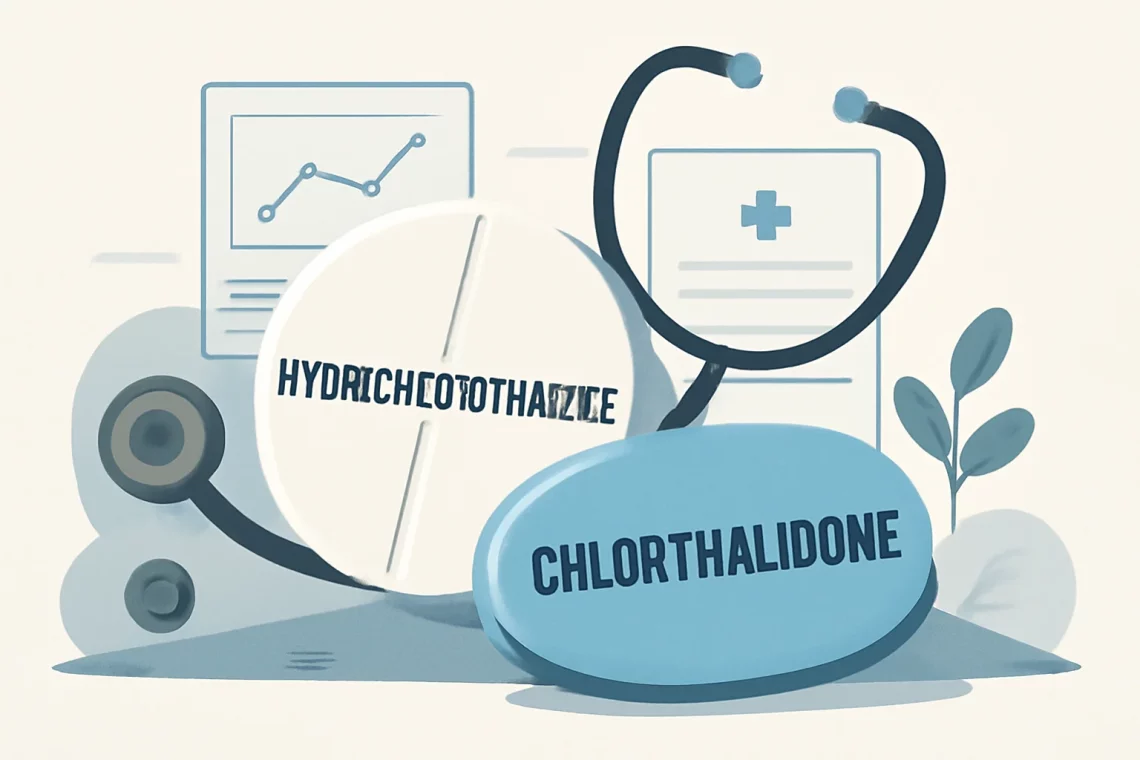
Hydrochlorothiazide vs Chlorthalidone: Choosing the Right Diuretic
High blood pressure and fluid retention are common health challenges faced by many individuals. Among the various treatment options available, thiazide diuretics, such as hydrochlorothiazide and chlorthalidone, have gained popularity due to their effectiveness in managing these conditions. Both medications work by promoting the excretion of sodium and water through the kidneys, helping to lower blood pressure and reduce swelling. However, despite their similar uses, these two drugs have distinct properties that can influence their effectiveness, side effects, and suitability for different patients.
The choice between hydrochlorothiazide and chlorthalidone often depends on various factors, including the patient’s overall health, the presence of other medical conditions, and individual responses to treatment. Understanding the nuances of each medication can empower patients to make informed decisions in collaboration with their healthcare providers. This article delves into the differences, similarities, and considerations surrounding hydrochlorothiazide and chlorthalidone, providing a comprehensive overview for those seeking to understand these commonly prescribed diuretics.
Understanding Hydrochlorothiazide
Hydrochlorothiazide (HCTZ) is an antihypertensive medication that falls under the category of thiazide diuretics. It is widely prescribed for the management of hypertension and edema associated with various medical conditions, including heart failure and kidney disorders. The primary mechanism of action for hydrochlorothiazide involves inhibiting sodium reabsorption in the distal convoluted tubule of the nephron in the kidneys. This action leads to increased excretion of sodium and water, resulting in a reduction in blood volume and, subsequently, blood pressure.
One of the notable advantages of hydrochlorothiazide is its relatively quick onset of action. Patients may begin to experience the effects of the medication within a few hours of ingestion, making it a convenient option for those needing rapid control of their blood pressure. Additionally, hydrochlorothiazide is often well-tolerated by patients, with a side effect profile that includes mild symptoms such as dizziness, headache, or gastrointestinal disturbances.
Nevertheless, hydrochlorothiazide may not be suitable for everyone. Certain populations, such as those with impaired kidney function, may experience adverse effects or diminished efficacy from this medication. It is also important to note that prolonged use of hydrochlorothiazide can lead to electrolyte imbalances, particularly low potassium levels (hypokalemia). Therefore, regular monitoring of electrolyte levels is essential for patients on this medication.
In summary, hydrochlorothiazide is a widely used thiazide diuretic that effectively manages high blood pressure and fluid retention. While it offers rapid action and is generally well-tolerated, careful consideration and monitoring are necessary to ensure patient safety and optimal therapeutic outcomes.
Exploring Chlorthalidone
Chlorthalidone is another thiazide-like diuretic that is often compared with hydrochlorothiazide due to their similar applications in treating hypertension and edema. Like hydrochlorothiazide, chlorthalidone works by inhibiting sodium reabsorption in the kidneys, leading to increased urine production and decreased blood volume. However, chlorthalidone has a longer half-life, which means it stays in the body longer and may provide more sustained effects throughout the day.
The extended action of chlorthalidone can be particularly beneficial for patients who require consistent blood pressure control without the need for multiple daily doses. Many healthcare providers appreciate chlorthalidone for its efficacy in reducing cardiovascular events, as studies have suggested that it may outperform hydrochlorothiazide in lowering blood pressure over an extended period.
Despite its advantages, chlorthalidone is not without potential side effects. Common adverse reactions include similar issues as those seen with hydrochlorothiazide, such as dizziness, electrolyte imbalances, and gastrointestinal disturbances. However, due to its longer duration of action, patients may also experience more pronounced effects, necessitating careful monitoring for signs of dehydration or electrolyte abnormalities.
Chlorthalidone may also be a better option for certain patient populations, particularly those with a history of cardiovascular disease or those who are at higher risk for heart-related complications. The decision to use chlorthalidone over hydrochlorothiazide should be made based on individual patient needs, preferences, and specific health considerations.
In conclusion, chlorthalidone is a valuable thiazide-like diuretic that offers prolonged action and effective blood pressure control. While it shares similarities with hydrochlorothiazide, its unique properties may make it a preferable choice for some patients, highlighting the importance of personalized treatment approaches in managing hypertension.
Comparing Efficacy and Side Effects
When it comes to the efficacy of hydrochlorothiazide and chlorthalidone, several studies have aimed to compare their effectiveness in managing hypertension and other conditions. While both medications are classified as thiazide diuretics and share a common mechanism of action, differences in their pharmacokinetics can lead to variations in clinical outcomes.
Hydrochlorothiazide is often favored for its quick onset of action, which can be advantageous for patients requiring immediate blood pressure management. However, chlorthalidone’s longer half-life allows for a more sustained therapeutic effect, which can be crucial for maintaining stable blood pressure levels throughout the day. Research indicates that chlorthalidone may be more effective in reducing cardiovascular events compared to hydrochlorothiazide, making it a valuable option for patients with a history of heart disease.
In terms of side effects, both medications have similar profiles, with common issues including dizziness, fatigue, and gastrointestinal discomfort. However, electrolyte imbalances, such as hypokalemia, are a significant concern with both drugs. Chlorthalidone’s longer duration of action can lead to a more pronounced risk of electrolyte disturbances, necessitating regular monitoring of potassium and magnesium levels.
Additionally, patient tolerance and individual responses to each medication can vary significantly. Some patients may respond better to one drug over the other, highlighting the importance of personalized treatment plans. Healthcare providers often assess patient history, comorbidities, and potential drug interactions when determining the most appropriate diuretic.
In summary, while both hydrochlorothiazide and chlorthalidone are effective thiazide diuretics for managing hypertension, their differences in efficacy, duration of action, and side effect profiles warrant careful consideration. A thorough evaluation by a healthcare provider is essential to ensure optimal treatment outcomes for patients.
Choosing the Right Medication for You
Selecting the appropriate thiazide diuretic for managing hypertension or fluid retention involves a multifaceted approach. Factors such as individual health status, existing medical conditions, and tolerance to medications play significant roles in this decision-making process. It is crucial for patients to engage in open discussions with their healthcare providers to determine the best option for their specific situation.
For patients with a history of cardiovascular issues, chlorthalidone may be the preferred choice due to its demonstrated efficacy in reducing cardiovascular events. Conversely, those who require immediate blood pressure control may benefit from the rapid action of hydrochlorothiazide. Additionally, considerations regarding potential side effects, such as the risk of electrolyte imbalances, should be thoroughly discussed.
Another important aspect to consider is the patient’s lifestyle and adherence potential. For example, patients who may have difficulty remembering to take multiple doses throughout the day might find chlorthalidone’s longer duration of action more suitable, as it often requires only a single daily dose.
Ultimately, the choice between hydrochlorothiazide and chlorthalidone should be guided by a comprehensive assessment of the patient’s health status, preferences, and lifestyle. Regular follow-ups and monitoring are essential to ensure the chosen medication remains effective and well-tolerated.
In conclusion, choosing the right thiazide diuretic involves a collaborative approach between patients and healthcare providers, taking into account various factors to ensure the best therapeutic outcomes.
**Disclaimer:** This article is for informational purposes only and does not constitute medical advice. Always consult your healthcare provider for advice regarding your medical condition and treatment options.




